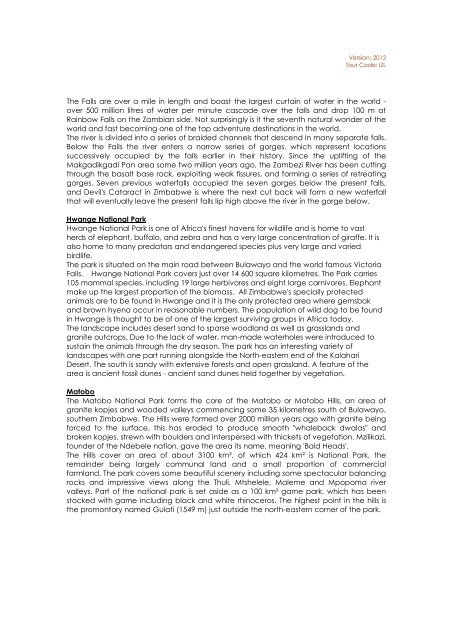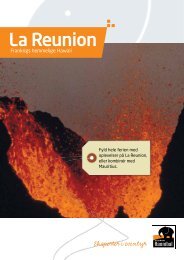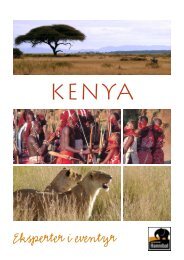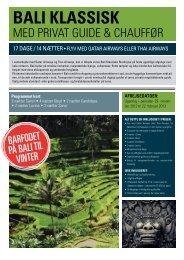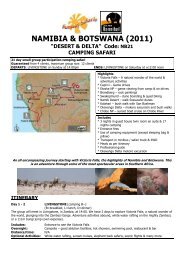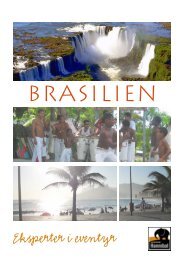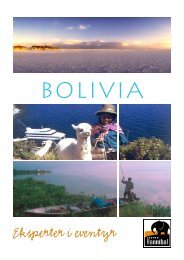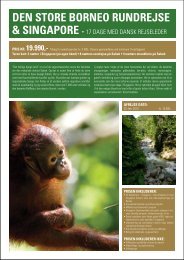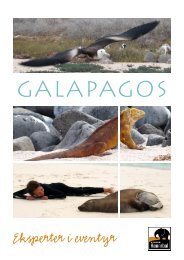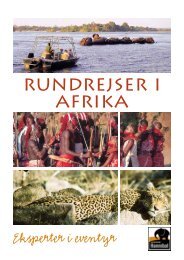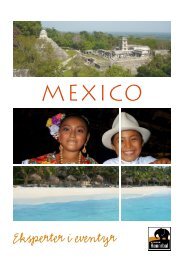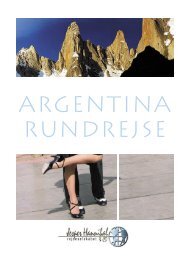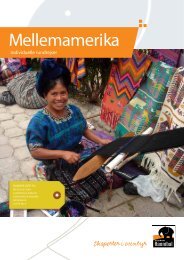15 Day Intimate Zimbabwe Lodge Safari A fully ... - Jesper Hannibal
15 Day Intimate Zimbabwe Lodge Safari A fully ... - Jesper Hannibal
15 Day Intimate Zimbabwe Lodge Safari A fully ... - Jesper Hannibal
Create successful ePaper yourself
Turn your PDF publications into a flip-book with our unique Google optimized e-Paper software.
Version: 2012<br />
Tour Code: IZL<br />
The Falls are over a mile in length and boast the largest curtain of water in the world -<br />
over 500 million litres of water per minute cascade over the falls and drop 100 m at<br />
Rainbow Falls on the Zambian side. Not surprisingly is it the seventh natural wonder of the<br />
world and fast becoming one of the top adventure destinations in the world.<br />
The river is divided into a series of braided channels that descend in many separate falls.<br />
Below the Falls the river enters a narrow series of gorges, which represent locations<br />
successively occupied by the falls earlier in their history. Since the uplifting of the<br />
Makgadikgadi Pan area some two million years ago, the Zambezi River has been cutting<br />
through the basalt base rock, exploiting weak fissures, and forming a series of retreating<br />
gorges. Seven previous waterfalls occupied the seven gorges below the present falls,<br />
and Devil's Cataract in <strong>Zimbabwe</strong> is where the next cut back will form a new waterfall<br />
that will eventually leave the present falls lip high above the river in the gorge below.<br />
Hwange National Park<br />
Hwange National Park is one of Africa's finest havens for wildlife and is home to vast<br />
herds of elephant, buffalo, and zebra and has a very large concentration of giraffe. It is<br />
also home to many predators and endangered species plus very large and varied<br />
birdlife.<br />
The park is situated on the main road between Bulawayo and the world famous Victoria<br />
Falls. Hwange National Park covers just over 14 600 square kilometres. The Park carries<br />
105 mammal species, including 19 large herbivores and eight large carnivores. Elephant<br />
make up the largest proportion of the biomass. All <strong>Zimbabwe</strong>'s specially protected<br />
animals are to be found in Hwange and it is the only protected area where gemsbok<br />
and brown hyena occur in reasonable numbers. The population of wild dog to be found<br />
in Hwange is thought to be of one of the largest surviving groups in Africa today.<br />
The landscape includes desert sand to sparse woodland as well as grasslands and<br />
granite outcrops. Due to the lack of water, man-made waterholes were introduced to<br />
sustain the animals through the dry season. The park has an interesting variety of<br />
landscapes with one part running alongside the North-eastern end of the Kalahari<br />
Desert. The south is sandy with extensive forests and open grassland. A feature of the<br />
area is ancient fossil dunes - ancient sand dunes held together by vegetation.<br />
Matobo<br />
The Matobo National Park forms the core of the Matobo or Matobo Hills, an area of<br />
granite kopjes and wooded valleys commencing some 35 kilometres south of Bulawayo,<br />
southern <strong>Zimbabwe</strong>. The Hills were formed over 2000 million years ago with granite being<br />
forced to the surface, this has eroded to produce smooth "whaleback dwalas" and<br />
broken kopjes, strewn with boulders and interspersed with thickets of vegetation. Mzilikazi,<br />
founder of the Ndebele nation, gave the area its name, meaning 'Bald Heads'.<br />
The Hills cover an area of about 3100 km², of which 424 km² is National Park, the<br />
remainder being largely communal land and a small proportion of commercial<br />
farmland. The park covers some beautiful scenery including some spectacular balancing<br />
rocks and impressive views along the Thuli, Mtshelele, Maleme and Mpopoma river<br />
valleys. Part of the national park is set aside as a 100 km² game park, which has been<br />
stocked with game including black and white rhinoceros. The highest point in the hills is<br />
the promontory named Gulati (<strong>15</strong>49 m) just outside the north-eastern corner of the park.


